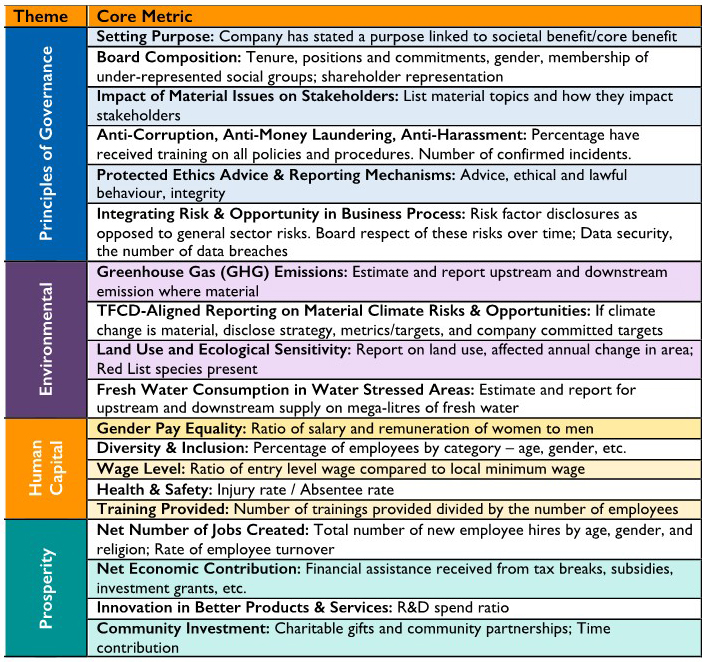How can you turn ESGR from compliance cost in your business to a source of inspiration and innovation for your staff, suppliers and customers?
TLDR – 🙂
What value can ESGR bring to your business … aside from helping to save planet and make the world a better place to live in for all? And what is the ‘R’ element
In this rather longish article, we explore some of the concepts around ESGR and how it can be a force for good in your business, whilst you are being a force for good in the world. We cover the what and why of ESGR, a little on the measurement and refer to the UN Sustainable Development Goals as a source for inspiration and innovation for your company.
Recently I had the opportunity to deliver a short introductory program for a new MBA cohort at a university here in Hong Kong to ESG. The idea was to cover the basic ideas around:
- What is ESG (&R)?
- Why does it matter?
- How do we measure it?
- What can we do about it?
Now I am sure that ESG is not new to you, but in case you hadn’t come across the term before, ESG stands for Environment, Society and Governance, or what has been called “Sustainability” or “Non-financial” reporting for public companies listed on stock exchanges around the world. It has also often been termed Corporate Social Responsibility (CSR). Of course it is important to private companies as well, but it has gained most of its renown from listing requirements and the NGO’s who have fought to raise the profile of ESG challenges around the world. The reality is that we have seen it make a significant difference to companies large and small, public or private, start-up or long-established.
I don’t plan to get too much into the history and evolution of ESG, and the related reporting requirements, in this article. Betsy Atkins does point to a seminal moment with the publishing of the 2006 United Nation’s Principles for Responsible Investment (PRI) report1. If you want to delve into the PRI further, check out their website2.
I would argue that western concepts of ESG have been evolving slowly since its nadir during the mid-late part of Industrial Revolution in the late 1800s, as businesses and society started to rethink working conditions (including slavery), along with the social and ecological impacts they were having on the world around them. Of course, this has been an extremely slow evolution, with many low points along the way – the Enron3, Minimata Bay4 and Deepwater Horizon5 tragedies being amongst them, but since the adoption of the UN Sustainable Development Goals by member states in 20156, a drive to improve business governance, and ameliorate the negative externalities of business on the global environment and human population seems to have accelerated. I believe the recent COP26 meeting in Glasgow7, with it’s “Nett Zero by 2050” push, and hard commitments made by governments, will further accelerate the adoption of better practices for the world.
So what about for your business? In our Strategy, Innovation and Change practice, we have long held that taking a long term view of your business, and exploring deeply how it interacts with the world around, can be an opportunity to grow the business in a sustainable way. Let’s explore the subject of ESG and how it can be a force for good in your business, as well as in the world.
We believe that in order to be truly, sustainably, successful in business, it helps to take a systems-thinking approach to business, based on an organisation purpose that built around servicing a deep need in society that you have identified. This goes to the very core Leadership Philosophy of the business. Why was your business founded, and what deeper needs in society are you addressing with your products, services and processes? Can you use this understanding to drive opportunities for innovation and improvement that will help you to deliver more value and grow? Can your business be a force for good in this world and be wildly successful at the same time?
Let’s get back to ‘What is ESG (&R)?’ and practically what it means for your business. We propose the following definition:
“Structuring the Purpose, Planning, Resources and Policies of an enterprise, to optimise the Products, Services, Processes and Partnerships to maximise the systemic positive impacts, and minimise the systemic negative externalities on the Environment and Society, including internal elements of business Governance and Long-term Planning. It is about looking after People and the Planet, as much as profit, in what is called the ‘Triple Bottom Line’”.
Harvard Business School defines Triple Bottom Line, in their introduction to their online Sustainable Business Strategy course as:
“The triple bottom line is a business concept that posits firms should commit to measuring their social and environmental impact—in addition to their financial performance—rather than solely focusing on generating profit, or the standard “bottom line.” It can be broken down into “three Ps”: profit, people, and the planet”.8
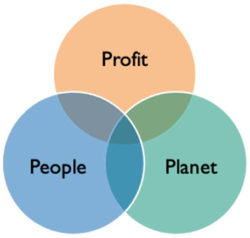
This brings us back to the very purpose of business. Whilst Drucker defined the purpose of business as “to create and keep a customer”9, we invite the reader to subscribe to the below 6 points, which we use to describe the purpose of business:
- Produce something(s) of value to society, based on (an) identified need(s) in society and the marketplace
- Make money (profits) for the owners of public or private business (or not lose it in the case of not-for-profits, or manage it efficiently in the case of government organisations)
- Provide jobs and a source of income for others, including taxation income for governments and jurisdictions in which the business operates
- Step lightly on the world around them, producing as much positive consequences and inflicting the least possible negative “externalities” to the environment and society of the world around d them, whether local or global
- Support the continuance of “trust” in society and economy with good governance, acting as a model citizen in the way it treats its staff, suppliers, customers and the broader market
- Once established, stay in business to continue the contribution of the above 5 points in balance
Are these points addressed in the Leadership Philosophy, Purpose and Strategic Planning of your business? Do you currently actively consider these points as part of your business purpose?
This also invites us to add one more ‘letter” to the ‘ESG’ term to complete the factors of long-term sustainability for organisations: ‘R’ for Resilience. The resilience element is all about considering the long-term trends in society and the marketplace, along with the potential interruptions in business continuity (risk analysis), such as the pandemic we are facing right now (which had been long predicted by scientists), climate risks, war and social unrest (such as the war in Ukraine, and protests that have occurred in various places over time). Some might consider this part of the Governance processes, and particularly the material reporting in the case of Risk Analysis for listed companies, but we believe this requires a section focus on it’s own. Thus we use the term ESGR when we speak of sustainable business strategy.
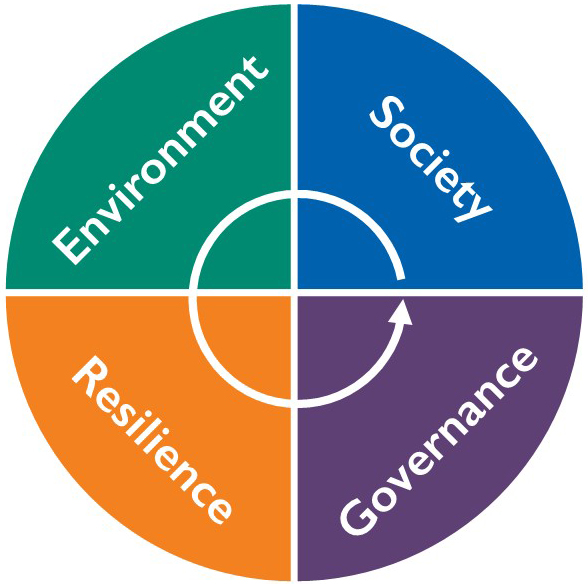
Such definitions of business, invite us to take on a systems-thinking approach to business (something we will address in more detail in another blog or vlog), but let me explore a causal thinking approach to business (financial and other) success with you. Whilst this may seem obvious, it is often not thought about carefully in the heat of day-to-day planning. In order to do so, we use the concept of the Business Balanced Score Card, proposed by Kaplan and Norton in the early 1990s10. Our version of the Business Balanced Score Card differs from that originally proposed by Kaplan and Norton, in that we refer to “People” measures, rather than Innovation and Learning in that fourth box (see figure below).

We start with the question, “Where does continuing business revenue come from?”. Immediately, you would recognise that it comes from customers who are so satisfied with the quality of our products and service that they are willing to purchase, and repurchase, again and again, repeatedly, and recommend our products and services to other potential customers. You might call this a positive Customer Experience.
This then leads on to the question, “What causes the customers to have such a positive Customer Experience?”. This comes from products and service that match a need or desire, delivered through effective operations. This combined with happy, motivated and engaged staff means happy customers. Or perhaps it is more important to recognise that happy staff will not necessarily directly mean happy customers, but the reverse is definitely true. Unhappy and disengaged staff will definitely result in unhappy customers. I have seen this played out in the extreme, when a staff member of a company I worked with, who was angry and hurt after being advised he was the victim of a restructuring, went about deliberately sabotaging the customer experience with that company. When it was discovered, he was summarily marched out of the door, but by that time an unknown number of customers had been impacted by his disaffection.
Moving back up the causal system, the question comes to mind, “What causes effective operations?”. This comes from well-designed and optimised processes, run but competent people who are engaged in the work they are doing. As we digitise and automate more and more processes, fewer processes are dependent on human technical competence, but the reality is that humans do business with humans, not machine-to-machine. This becomes obvious, when something goes wrong, and a human must apologise to another and fix it.
Another important element of operations feeds back into the financial aspect. Not only are effective operations (whatever they may be) important to customer satisfaction, but operations must be efficient in terms of cost. This feeds into the profitability of an organisation, by simplistically observing that profit equals revenue minus costs. Of course, with everything, the devil is in the detail. I have addressed a systems approach to business operations in any earlier blog (Profound Knowledge: The Foundation of Science in the Art of Strategy, Innovation, and Enterprise Improvement). To summarise, effective and efficient operations come from competent and engaged staff running processes tuned to the need in the marketplace.
And going further up in this story, “What builds happy, competent and engaged people?”, and how do we measure that? Some of it is around learning and growth (as Kaplan and Norton point out) and around experience of the enterprise (and the satisfaction of people within in it. Moreover, there are deeper measures around structure, and roles (including turnover, efficiency to back-fill, etc.) that are more operational in nature. And finally, a big part of it is around staff feeling like the work they do has meaning and purpose and that they are appropriately rewarded and recognised for the work that they do. What is the big “why” for the organisation, and how well do the people working there feel that their personal “why” is aligned with the company’s stated purpose and vision? Do the people working there feel like they are contributing something valuable to the world around them? Are they inspired by the innovative approach that your business takes to solving the problems that the planet and our society face? Do they feel that the organisation is here for the long-term to make a difference? And now we are back to ESGR! We really need to be having a constant dialogue with our people about what drives them, how their competencies can make a difference (and what more they can do to develop them) and what they can do to be involved in the company’s innovation and improvement drive.
We can think of our business measures in the short-to-medium term (from months to 1-2 years), and then in the longer-term horizons, and start with the impact we make on the world, beyond this year’s, and perhaps next year’s, profit. This prompts us to take a Sustainable Balanced Score Card approach.
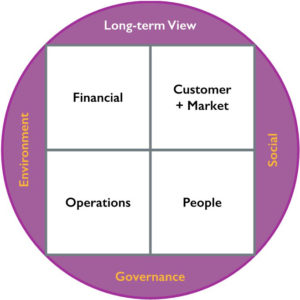
In the middle of this pandemic, with a war going on in Europe, some might say, “Look I am barely surviving, and I don’t have spare money to throw at such exercise! I need to focus on making money.” The question I would ask then is “How?”! Beyond the immediate tactics of cutting costs and paring down to what is necessary, how will you inspire your market to buy more? How will you engage your team to be more innovative, and come up with ideas that will help you adapt and grow your business? Where is the vision that will lead to a better future?
The reality is that some of the initial work you might do on the ESGR side of things could save you some money (particularly as you measure and explore energy efficiency), and setting a vision and targets toward a better future. You start to engage people towards getting there. More importantly, by creating focus and galvanising your people towards a shared vision around a kind of “profitable ESGR”, you can create a growth momentum in your business.
What are some of the things you can work on? The Valero, an energy company (yes, I know … a petroleum refiner, which also produces renewable fuels such as ethanol!) has listed some of ESG factors that you might work to improve your impact on the world around you as a business11, referred to in a World Economic article which also reinforces our concept of Resiliency as part of the ESGR focus12. We have added some factors on Resilience that you might work on. To trigger your own business, you simply need to ask the question, “How can we work on <insert relevant factor here> in our business?”.
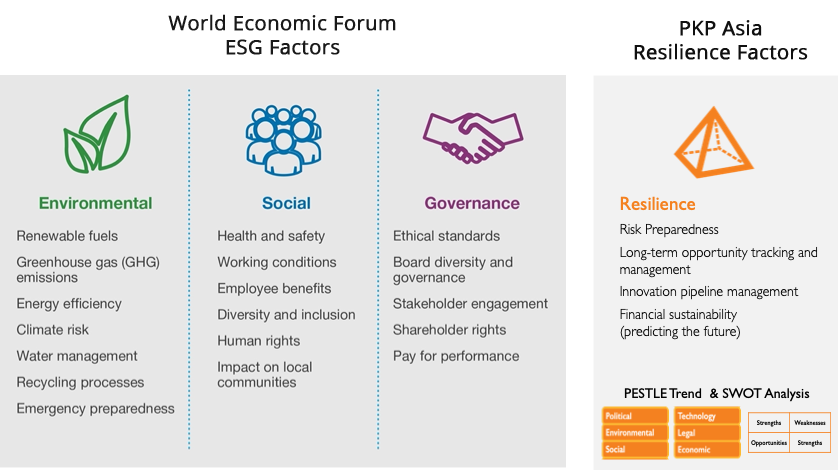
Of course, that’s when the challenge truly comes alive… but nothing engages human beings more that working together to solve meaningful conundrums that will make a difference. As Ranjay Gulati, Havard Business School professor, points out in an interview about research that he did on purpose and performance of organisations13, “We need to go beyond purpose as wall paper”… “We need to get the purpose and culture part right”… helping people experience “a sense of pride” and engagement in the work they do.
He goes on to relate, “When you don’t have a clear understanding of your purpose, what you typically start to see is unfocussed strategies… strategies that are opportunistic. You see the lack of focus over there. You see an organisation where you live up to what economists have described organisations as a ‘nexus of contracts’ – people show up to work as a job, and you end up defaulting towards shareholder maximisation as the only metric you understand. And so, you create this self-fulfilling loop, where that’s the organisation you are in.”… “inert, alienated work environments”… “where people are focused on only one key metric”, ie. the Finance quadrant, squandering the opportunity to engage the hearts, minds, and perhaps souls of the people working with you.
Setting the purpose and building a culture of “trust and responsibility” in an organisation galvanises performance and gets us to think about metrics in detail. How will we measure ourselves, which get us back to the Sustainable Balanced Scorecard we covered earlier. Before we get into some of the metrics, let’s talk about what we can do to move things along.
How do we start? One useful resource to explore as a business to build a vision and measurement system is the United Nations Sustainable Development Goals (UN SDG’s). These 17 Goals and their related 169 targets, set for 2030 (sooner if possible), set a global direction for making the world a better place.

To delve deeper into the UN SDG’s check out the UN site here and the business-focussed site here. By helping your organisation become familiar with these goals, and investigating where your business connects with these goals and targets, especially where your business operates, it can become an inspiration for vision-setting and innovation for your enterprise. The UN SDGs, together with Project Everyone, point out five actions that all businesses can take towards these SDGs14. This is a useful resource, as they have some good (free) guidance tools to get your business started (you may find it easier to work with a consultant such as ourselves).
I. BUILD YOUR CASE
First, identify the business opportunities represented by the Global Goals, then hold an execut(ive) management meeting to articulate your strategy and get the board on…board.
II. ASSESS YOURSELF
Wondering how you measure up?Use the SDG Action Manager to assess your impact and identify the top risks and opportunities. Use this to define your priorities and set clear goals and targets. [They provide a goal-setting tool]
III. LET THE GOALS LOOSE
Make sure your employees know about your mission to be a force for good in the world. Don’t keep the goals locked in the sustainability team, let them loose! [They have a great employee guide].
IV. SHOUT IT FROM THE ROOFTOPS
Show your customers how you are contributing by including Global Goals icons and branding on your website, communications materials, social media announcements etc. Link your sustainability announcements to the corresponding Goal(s). Delve into our branding resources and get posting! [They have lots of useful communication support materials for free!]
V. PARTNER UP
No company is an island. Partnerships are essential to achieving the Goals and there are SO MANY amazing organisations and initiatives out there to help you on your way. [They have a list of useful NGO’s and other’s you can partner with to accelerate your journey].
Not convinced yet? Let’s look at some of the reasons why ESGR is becoming a strategic imperative.
A. Business funding
Banks and private investors have been increasingly using ESG performance as a gateway to their decision-making on both equity and debt funding. According to Robert Eccles, visiting professor at Said Business School at University of Oxford, interviewed by HBR Ideacast in May 2019 on topic on “Why it’s time to finally worry about ESG”15, 50% of financial assets in Europe are related to sustainable investing, with about 33% in Canada, and about 25% in USA. Banks and investment houses such as HSBC, UBS, Black Rock and most other large players have specific targets to increase their investment in sustainable enterprises and reduce investment in industries or businesses that fail to show progress on the ESGR front. This is currently material for largely listed companies, but more and more, early stage funding from private investors are also being tied to longer-term ESGR vision and current ESGR performance. Perhaps your business doesn’t depend on external funding, but it is something to consider.
B. Regulation
Aside from some specific employment, pollution-related, anti-money-laundering, and other corruption-related regulations, most ESGR-related activities are not mandatory. Sure, there are reporting requirements that all exchanges set out for public companies. It should be noted that the financial rules are mostly mandatory, but those for sustainability reporting are not consistent across boards or reporting frameworks (although there are efforts to align these)16, and much of the reporting is a “comply or explain” basis (meaning there is not specific censure for not complying) – see the HK Exchange requirements as an example. This is starting to shift again in many jurisdictions. Europe is leading the way (for example the GDPR regulations) but others, including many in Asia, are following fast, given that much of the world’s business continues to evolve in a globalised way. And with governments having made some significant promises at the recent COP26 meeting in Glasgow, businesses will be pushed to deliver on those commitments, if not voluntarily, then through regulation. Do you want to wait until you have the regulations thrust upon you and reluctantly change, or get ahead of the curve?
C. Reputation & trust management
For some companies, ESG has become fundamental to their future survival. Examples such as BP and other energy companies are truly embracing sustainability, partly (if I am to be cynical) as penance for past failures, but more and more that they believe it is a path to the future for their “dirty” industries.
Many Textile, Clothing and Footwear companies have had their reputations damaged due to their lack of care about how their contractors had looked after their staff and the environment. More and more, Social- and Eco-activists and NGO’s with cameras and social media accounts are holding businesses accountable for their negative externalities. Some companies have managed to recover from being “caught out”, however invariably the cost to reputation, and in monetary terms, have often been enormous (think of the billions that BP has paid in fines and compensation after the Deepwater Horizon disaster)5.
In many cases, consumers lose trust in the company after transgressions “break the news”, something that is difficult to recover afterwards, and forever dogs their reputation, contributing to limitations on growth. Often these instances are not only directly perceived ESGR failures from the company, but those of their upstream suppliers and their downstream contractors, as exampled by “charges” against Nike for using child labour and sweatshops in the 1990s-2000s17.
And, look at how quickly companies have moved to distance themselves from suppliers or downstream businesses in Russia after that government’s invasion of Ukraine18, some because they believe it is the right thing to do, and some because they fear sanctions on their own company or a negative response from society.
D. Marketing
ESGR approaches to products, services and marketing can represent an opportunity for your your business. You only have to look at the growth in sustainability related engineering particularly in the electrical products and power generations industries, along with ‘organic’ product marketing of foods, and many other examples designed to drive virtue signalling.
One example I particularly liked was the approach that Toms (the shoe company) took. They drove their growth campaign by giving away over 1 million pairs of shoes and boots via Save the Children Fund to those in need, in a “Buy one, give one” approach. This meant that every time you bought a pair of their shoes, they would donate a one new pair to people in Africa or elsewhere19. The virtue signalling from this campaign spread like wildfire as many people who wanted to feel good purchased Toms shoes.
We also work closely with another consulting company who do something similar. Every time they deliver a program for a client, they take a portion of the fees and fund a charity that they choose (based on earlier discussions with the client) through an arrangement with B1G1, the Business For Good company. They announce at the end of the engagement to all who were involved which charity and what was done (impact), and this has contributed repeat bookings and increased revenue, as everyone involved on both sides feels good about this.
How might you apply sustainability marketing (and make it real, as “greenwashing” is being discovered and called out more and more – see point C above). How can you authentically tell your customers and the market about the good you are doing? Can you take that further, and do more, like the Veterinary Group I have worked with, who donate time and resources to support the veterinary needs of animal shelters free-of-charge?
E. Good business sense
In our experience, working with customers who really do this well, could not see themselves going backwards in terms of ESGR. Companies like Marks and Spencer, with their “Plan A” approach track supply provenance and ensure that their whole supply chain is as sustainable as it can be, and improves over time not only because it is part of their brand promise, but they see that it just makes good sense. They see that the business development, process improvement, product enhancements, increased pride and engagement of staff and customer relationships emanating from the approach make their business more efficient and effective.
Another business example is Link Real Estate Investment Trust (LINK REIT) whose “Business As Mutual” approach has become a core part of what they do. Their business model is in owning and managing retail facilities, car parks, offices and logistics centres in Hong Kong and beyond. Regularly, they sit down with their tenants to have an important discussion – “What are the most material business challenges that are facing the tenant?” – and then they do what they can to support the tenant in those challenges, without directly intervening in the tenant’s business. In this way they work on their own sustainable profitability by helping their tenants to continue to be successful, whilst reducing turnover and increasing visibility to oncoming risks. As I said, this just makes good business sense, even in the dog-eat-dog property market of Hong Kong.
F. Assuring the future
Speaking of risk management, the rigour of a well-planned approach to strategic ESGR calls on the company to undertake ongoing trend and risk analysis. By taking a long-term view and widening the information horizon, companies begin to identify both opportunities and threats much earlier. This puts them in a better position to prepare for and assure the future, building plans to address when they learn from the analysis – whether innovation efforts from identified opportunities or contingency plans in the case of identified risks.
One company I have worked with had kept aside a ”war chest” of cash – in case of emergency – for more than a decade, as their business grew. They simply salted away a small amount every month, year-after-year, without fail. It was not easy, especially in bad times, and rather tempting to raid the war chest as they went along, particularly when they needed money to fund expansion. However, they resisted, and it is what saved them as the Covid-19 pandemic hit. With their revenue suddenly drying up, they were able to use the cash to pivot their operations, and survive, albeit at a much lower level. None-the-less, they did survive and they have a foundation for future growth. Without it, they would have been gone in less than six months.
G. Business management trends
More and more when I talk with CEO’s and senior business leaders, they have made ESGR a part of their strategy and I see them competing with each other on virtue-signalling. Adoption of ESGR as part of the way companies do business has gained significant momentum, particularly over the past five years, and this is starting to spread from business-to-business. Do you want to be one of those business leaders when their staff or others ask them about ESGR, can’t answer?
H. Employee engagement
Speaking of staff, it has become a bit of a meme that millennials want to “save the planet”, but there is also significant truth in that. When senior regional leaders at a major global bank with which I was working were tasked to interview young recruits about what was most important to them, as part of a leadership development program, they were surprised at the amount of emphasis the new staff placed on CSR. They found, when given the opportunity in a ‘safe’ environment, that recruits began to challenge the investment strategy of the bank, particularly as it related to sustainability.
Those same recruits also wanted to do more as an organisation to be engaged with local charities and environmental causes, as part of team-building activities. What became clear through this exercise, as they started to explore the results with other leaders in the organisation, was that more people across the organisation wanted to be associated with a company that “did good in the world” in a material way than they had predicted. It was listed as a reason to join, and leave, the company.
Ranjay Gulati, whose research I mentioned earlier, also indicated that the difference between companies whose employees turned up for the pay check and those who’s staff were engaged and delivering discretionary effort, was a sense of meaning and purpose to what the company did. This gets back to the “why” in the Business Balanced Score Card discussion also earlier in this article. An example of this relates to the Veterinary Group I mentioned earlier. On top of wanting to deliver the best service, and good working conditions, staff wanted to do something outside of the business. Supporting animal shelters has become a part of what this company does, and their staff love being able to help.
I. Personal ethics & Leadership Philosophy
Ultimately, it comes down to belief. What is more important – profit at all costs (not that I am accusing many businesses these days of the excesses of the 1980s), or a balanced approach to business success? Now, I am also not advocating ESGR at all costs. Fundamentally, most businesses (unless that is their core purpose) are not designed to be simply social enterprises. If a business is not profitable (high margins are not a sin, unless they come at unacceptable social and environmental costs not paid for by the company), then it is simply not sustainable. Fundamentally, ESGR is the right thing to do. The trick is to turn it into a core part of the business strategy that contributes to the overall success of the enterprise, and engages customers, suppliers, employees and business partners alike.
Building off the UN SDGs, what can a business do to make ESGR a part of its core strategy:
1. Look to your company’s business purpose and vision: Does it incorporate an intent to do good, or great, in the world, whilst addressing deep-seated needs in the marketplace? Do you use it as a lens of business decision-making. Do you live the approach as a leader and is it reflected in your strategic objectives? If so, do your staff, customers, suppliers and business partners all know that and apply the same thinking in your business?
2. Explore what is strategically relevant for your business: Randomly doing good for the sake of “being good” is a nice thing to do, but hardly strategic. With your leadership team, consider which ESGR themes align with your business sector? Consider how you might use the strengths of the business and potential innovations towards that end? For inspiration, again you can look to the UN SDGs., or to the World Economic Forum Core ESG Measures as summarised by Betsy Aitkens in the Forbes article I mentioned at the start of this blog (and you can find the table at the end of this blog).
3. Look to your business operations: Can you find ways to “Step more lightly on the world”, and at the same time save money (by reducing power consumption for example, or sourcing power from more sustainable sources, etc.). By doing so, can you improve operations to be more effective and efficient, whilst maintaining or improving product and service quality? There are opportunities to reduce operational costs or increase revenue with a strategic ESGR approach.
4. Communicate the good that you are doing: Perceived ESGR performance is becoming a driver for consumer spending. How can you let your (potential) customers know what you are doing? How can you more deeply involve everyone in the company, so they are talking with your customers, suppliers and partners about it? How can you integrate it into your marketing approach, particularly with social marketing? And, how do you let potential investors know what you are doing in the ESGR space? It might just be the thing that tips funding in your favour.
5. Work on your product and service innovation: How can you set in motion an innovation drive aimed at making your products, services and processes better for the environment and society? What research can you do in the marketplace to explore customer dilemmas and opportunities for your business to address challenges that your (potential) customers face? Can you turn your ESGR initiative into a driver for growth in your business with new and improved?
Governance: In reality, the place to start first is on the ‘G’. If you don’t have solid governance principles and mechanisms, including appropriate reporting, for your type and level of business, then your remaining ESGR efforts are eventually likely to run into trouble.
At this point, you may be asking yourself, is there evidence that all this effort is worth it? Aside from the potentially reduced negative externalities, which your business currently does not measure and cannot know the cost you are placing on society and the planet, it has been proven that the performance of companies which build ESGR into their core strategy perform better more broadly than those who do not. Certainly Morgan Stanley seem convinced that sustainable enterprises outperform as an investment20. State Street Global Advisors, a large bank-backed asset manager, also point out in a BusinessWire21 article that 68% percent of institutions that have included ESG investments into their portfolios have seen there returns improve directly linked to those investments.
Of course, as they say, “the proof is in the pudding” – that is in the preparation and cooking of it. Anyone can mess up a good recipe if they lack the necessary skills or make a half-hearted attempt at it. Some businesses, who have taken a compliance approach to ESGR simply see the costs and the drag on profits. This is not strategic ESGR but we all know businesses that do the bare minimum to survive, with little vision of a different future.
One final thing to consider before we close up this article is how to measure your ESGR efforts. If you don’t have a measurement plan, the NASDAQ ESG Reporting guide (see table below) could be a good place to start. One of the challenges with measurement is the data management. You may want to engage with consultants such as Turnkey Group who specialise in helping you to integrate cloud-based data management systems to support your ESG measurement and reporting, across scope 1, scope 2 and even scope 3 if you require. For more information on Scope 3 reporting, particularly as it relates to Carbon Footprint, check out the Greenhouse Gas Protocol22.
Nasdaq ESG Reporting Measures
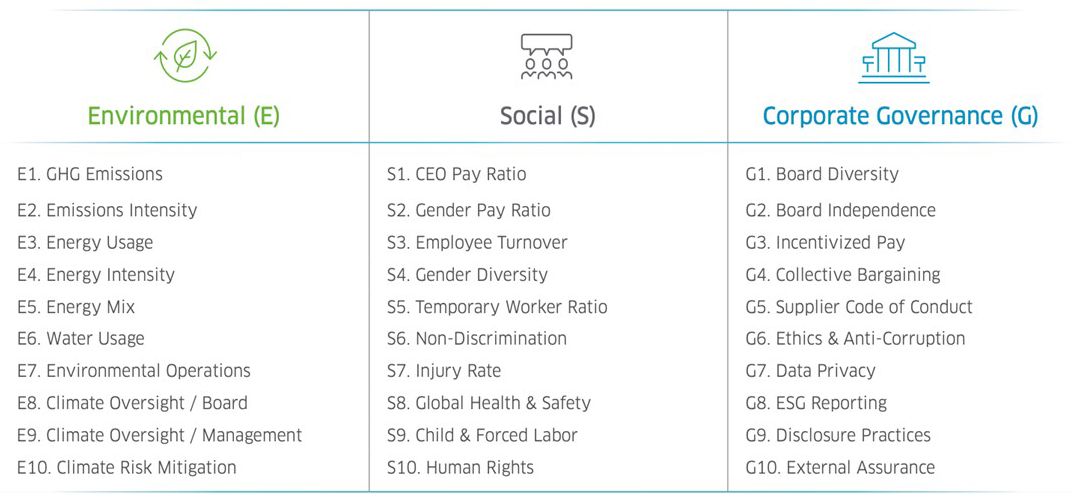
If your business already has a mature approach to measuring ESG, what can you do to build that measurement system down into your operation and innovation pipeline. Is it integrated into the culture of the company, with the role descriptions, and rewards and recognition systems reflecting it? We would love to help you take your ESGR approach into a deeper, strategic program.
Fundamentally, all businesses must ask and answer these questions with respect to the environment and society around them:
✓ Where do our responsibilities start and end?
✓ To whom are we responsible?
✓ How do we demonstrate this?
✓ What potential unintended impacts are we causing inside or outside of our enterprise?
✓ What can we do to ameliorate these impacts?
✓ How can we find business opportunities in addressing these impacts, or those of others?
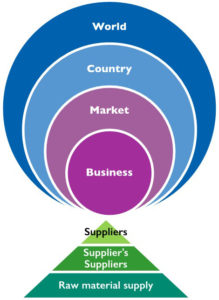
And then decide what to do about those answers. We believe that there are considerable business opportunities in doing good in the world, and ESGR can be a source of growth for your business, not just a compliance cost. We encourage you look to your company’s vision and strategy. How can the world benefit more from what you do, and can your business benefit as an outcome as well?
It starts with a bit of soul-searching and examining the collective belief of the business and then refocussing your efforts to take advantage of what you learn. If your business is new to ESGR, we hope that this article has given you some ideas to work with.
If your business already has a strong ESGR drive, as a business leader, as yourself, how can you deepen and broaden the approach to engage more of your people, and make it a key driver in your business improvement and innovation drive?
And for those who have a keen concern about Global Warming and what came out of last year’s COP26 meeting in Glasgow, we suggest you have a listen to the McKinsey podcast from Nov 2021, “COP26 made net zero a core principle for business. Here’s how leaders can act”23. Whether you are more recent to the party, or have a long history with ESGR, we’d love to hear your thoughts on the matter. Drop us a line: Enquiries@pkpasia.com
Resources:
1. “Demystifying ESG: Its History & Current Status”, Betsy Atkins, Forbes.com, Jun 8, 2020
2. United Nations Principles of Responsible Investment website
3. Wikipedia: Enron Scandal – Accounting standards failure
4. Wikipedia: Minimata Bay – the effects of Mercury Poisoning
5. Wikipedia: BP Deepwater Horizon explosion and subsequent oil spill
6. The UN Sustainable Development Goals History, United Nations Department of Economic and Social Affairs website
8. “The Triple Bottom Line: What it is and why it is important”, Kelsey Millar, Harvard Business School online Sustainable Business Strategy course introduction, Dec 8, 2020
9. “The Practice of Management”, Peter F Drucker, Harper Business publishing, 1954
10. “The Balanced Scorecard—Measures that Drive Performance”, Robert S. Kaplan and David P. Norton, Harvard Business Review, Jan-Feb, 1992
12. “ESG is missing a metric: R for resilience”, Judith Rodin and Saadia Madsbjerg, World Economic Forum Blog article, WEForum.org, Apr 19, 2017
13. “Inside Companies that get the purpose-profit balance right.”, interview with Prof. Ranjay Gulati, HBR IdeaCast Ep. 841, Feb 15, 2022
14. UN Sustainable Development Goals Action Guide for business website
15. “Why it’s time to finally worry about ESG.”, interview with Prof. Robert Eccles, HBR IdeaCast Ep. 683, May 21, 2019
16. “The backstory and purpose behind 5 leading ESG reporting frameworks”, Ellen Weinreb, Greenbiz.com, Mar 25, 2020
17. “How Nike Embraced CSR and Went From Villain to Hero”, Andrea Newell, blog on triplepundit.com, June 19, 2015
18. “Here Are the Biggest Companies Distancing Themselves From Russia”, Eloise Barry, article on Time Magazine website, Mar 3, 2022
19. “Buy One, Give One: What TOMS Shoes Tells Us About the West’s Urge to Help Africa.“, Blog article on theurgetohelp.com, May 11, 2018
20. “Why Sustainable Companies Can Outperform“, Audrey Choi, Access blog on the morganstanley.com website, 2017 (not specifically dated)
21. “Asset Owners Say Integration of ESG has Significantly Improved Returns, State Street Global Advisors Study Shows”, Survey report on BusinessWire.com (a Berkshire Hathaway publication), Apr 19, 2017
22. “Technical Guidance for Calculating Scope 3 Emissions”, Greenhouse Gas Protocol guidance, 2013
23. “COP26 made net zero a core principle for business. Here’s how leaders can act”, The McKinsey Podcast, Nov 12, 2021
Appendix: World Economic Forum Core 24 ESG Measures as summarised by Betsy Atkins in Forbes1
